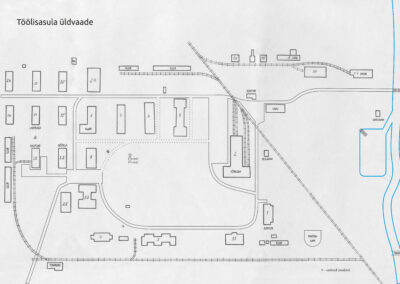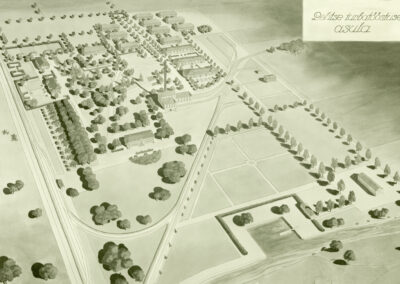Rabasaare (in English)
In 1936, a settlement began to take shape on an empty sandbank in the midst of swamps and bogs that was referred to by locals as Hindrekumäe Hill. Initially, this swampy, overgrown site was used only by farmers from the neighbouring village of Ojaküla as pasture land. The National Peat Industry decided to establish a machine peat company here, which was named Lehtse Peat Plant. The decision to establish the plant in Lehtse was not a difficult one, as peat production in the area had begun decades earlier. Namely, under the aegis of the Lehtse Agricultural Society, the Lehtse Peat Consumer Community had been founded in 1909 and was the first of its kind in Estonia. As a result of the new plant being established in 1936, an industrial village arose in the previously uninhabited Rabasaare where everything necessary for life was available. For the first few decades, all business with the rest of the world was via a narrow-gauge railway. As peat production required a lot of manpower, especially in the early years, a highly diverse group from different parts of Estonia came through here looking for seasonal work. It is known that the bog served as a place of shelter to people in times of crisis as far back as ancient times. Here, in the middle of the swamps and bogs, far from human settlements, those who sought to go unnoticed by foreign powers or hide their past also found work and shelter. When choosing the location of the plant, the National Peat Industry based its decision on the need to build the company as close as possible to the Tapa railway hub, from which it would be possible to transport peat cheaply to Tallinn, Rakvere, Narva and Tartu. A suitable natural site and an industrially compatible bog were found a few kilometres north of Lehtse railway station, where the peat-rich deposits of the Läste and Rebase bogs were located. By December 1936, more than 10 km of railway lines had been completed, which also enabled the construction of housing. By the end of that year the first two buildings had been completed, which helped the workers survive winter on site in greater comfort. By the beginning of June 1937, 10 dormitories for workers and one dwelling for workers with 12 apartments had been completed, and an office building was under construction. The Lehtse Peat Plant settlement was designed by civil engineer Dimitri Tõnisberg. Two types of housing were used to accommodate workers. Permanent workers were set up in so-called winter dormitories, where they could nevertheless live throughout the year, while there were summer dormitories for seasonal workers, which the people there referred to as barracks. A workforce of 657 was considered necessary in the planning of the peat plant, of whom 65 lived permanently on site and 592 were seasonal workers. The entire 17 km of the railway network was completed by May 1937, which enabled the first season of peat production to start smoothly. On 8 May 1937, the production of machine peat with six peat machines was officially launched at Lehtse Peat Plant. During the first season, 560 people were employed in the facility together with construction workers. The initially high demand for manpower decreased year on year due to technical progress. The cutting of peat bedding by hand was terminated at Lehtse in 1960 and the production, drying and cleaning of lump peat was fully mechanised a year later. The dormitories were also closed down that same year. Some of the empty dormitories were demolished for repurposing as building materials; new applications were found for the other buildings. The steady decline in lump peat production over the years was partly due to a decrease in the area of drying fields. The commissioning of the Oru briquette plant and the transition of large-scale boiler houses to oil and gas heating also played a role in the production of heating peat coming to an end. Production of heating peat was terminated in Lehtse in 1971. In the course of 35 years, Lehtse produced a total of around 800,000 tons of lump peat. Peat production was seasonal work and in the summer months there was enough work for everyone. In order for there to be sufficient work also during the winter months, especially for women, more emphasis was placed on the production of new consumer goods. In 1969, the mill became the first in Estonia to launch production of inflatable rubber mattresses. Five years later, in 1974, car seat belt parts went into production at Lehtse. Thanks to the introduction of these new products, there was also enough work for those who came from outside the settlement, especially women. The production of inflatable products ceased in Lehtse in early 1990. Seat belts were still being produced to a small extent in 1991, but due to Estonia regaining its independence, the bottom fell out of the Russian market, for which they were primarily intended. The Tootsi Lehtse division of the National Joint Stock Company was established on 7 May 1991. Various companies sought to keep up with the winds of change, including by looking for partners from abroad, but this did not lead to great success. The railway track was removed in 1978 and the bus line to the settlement was discontinued in 1992. On 1 November 1994, the buildings at the RAS Tootsi settlement were transferred to the ownership of Lehtse municipality. Under the leadership of NGO Rabasaare Holiday Camps, founded in 1995, hikes to Ojaküla were organised between the quarries. Various seminars were held and people extracted new energy from the local energy fields. With Government of the Republic of Estonia Regulation no. 244, a new settlement, the village of Rabasaare, was established on 18 December 1997. Life in the bosom of nature was nice, but time went by and people started moving away to paces where there was work and better living conditions. Every year, its buildings lost residents and began to fall apart – a state to which people contributed through their careless attitudes. The last permanent resident of Rabasaare left the village at the end of 2019. So is this the end? No – everything carries on. This is not the end of the holy attempt at creating Rabasaare. Someday everything will start again…
Rene Viljat, 2020
P.S. The history of Rabasaare is discussed in more detail in the book From Lehtse Peat Plant to Rabasaare compiled by Rene Viljat and published in 2018. If you are interested in buying the book, please call +372 322 9659 or +372 52 90 785 or e-mail indrek.jurtsenko@tapa.ee. If you would like a guided tour of Rabasaare, please call +372 52 58 325 or e-mail reneviljat@gmail.com.
CHRONOLOGY
1909. The Lehtse Peat Consumer Community becomes the first of its kind to be established in Estonia.
1913. Production of industrially shovelled peat commences in Läste bog in Lehtse.
15 June 1921. Establishment of OÜ Kungla Peat Plant.
25 February 1936. The National Peat Industry founds Lehtse Peat Plant.
8 May 1937. Operations are launched at Lehtse Peat Plant by the Estonian Peat Plants company.
12 August 1938. The Lehtse Peat Plant hunting society is founded.
24 May 1939. Eight new timber buildings are destroyed in a fire.
September 1947. The prison camp at Lehtse Peat Plant is closed.
1947. The plant becomes the first in Estonia to start producing peat bedding industrially.
1949. A peat-bedding baling factory is built.
1949. The TEM excavating peat machine is put into operation.
1952. Extensions to the club are completed.
1953. Mechanised production of milled peat commences.
December 1955. The newest, three-storey residential building burns down.
1956. Extensions are added to the repair workshop.
25 December 1957. Residential building no. 11, with its eight apartments, is formally accepted. It will become the last residential building in Rabasaare.
1958. The cleaning of heating-lump peat is fully mechanised.
November 1958. The silicate plaque in front of the club is completed.
1959. The peat-bedding baling factory burns down.
1959. The first building is completed on Uus Street in Lehtse.
1960. The cutting of peat bedding by hand is terminated.
1961. The production, drying and cleaning of lump peat is fully mechanised.
16 February 1961. The dormitories are closed down.
December 1962. Operations are launched at the crosstie impregnation factory.
1 January 1963. The Järva Paide Peat Plant manufacturing company is merged with Lehtse Peat Plant.
1963. The production of peat fertiliser commences.
1965. A garage for tractors is completed along with a boiler house and wood dryer next to it.
1965. Lehtse Peat Plant is renamed Lehtse Peat Mill.
3 October 1966. The working week is shortened to five days.
1966. The silicate materials warehouse is completed.
1968. The building at 4 Uus Street in Lehtse is completed. It will become the final one on this street.
1969. The mill becomes the first in Estonia to launch production of inflatable rubber mattresses.
1970. The kindergarten moves to building no. 3, made from silicate.
1 January 1971. The Lehtse division of the Tootsi manufacturing company is formed.
1971. The production of heating peat is terminated.
1974. The production of car seat belt parts is implemented.
1974. The baling of peat bedding is terminated in Lehtse.
21 May 1975 The Paide production area is closed.
1978. The railway is removed.
Summer 1990. The production of rubber mattresses is terminated.
7 May 1991. The Tootsi Lehtse division of the National Joint Stock Company is established.
30 September 1991. The Lehtse branch of AS P. R. K. Project is founded.
1 February 1992. The peat plant’s kindergarten is closed.
1 October 1992. The Lehtse branch of AS Estree Project is founded. It will close on 20 April 1995.
1992. The bus line to Rabasaare is discontinued.
1 November 1994. RAS Tootsi transfers the buildings in the settlement to the ownership of Lehtse municipality.
11 September 1995. The NGO Rabasaare Holiday Camps is established.
18 December 1997. Government of the Republic of Estonia Regulation no. 244. A new settlement, Rabasaare village, is established with the changes to the dividing lines of Lehtse village.
2009. The clubhouse is burned down in an act of spite.
15 September 2018. Presentation of the book From Lehtse Peat Plant to Rabasaare in Rabasaare.
18 May 2020. The last permanent resident of Rabasaare leaves the village.


